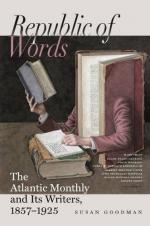We think that all works of Art may be divided into two distinct classes: those which are the result of a man’s whole nature, involving the affectional, religious, and intellectual, and those which are the productions of the intellect, and from the will. The first class comprises those results of Art which are vital,—which come to us through processes of growth, and impress us with a sense of organization. The second includes those works which are constructed,—which present an accumulation of objects mechanically combined, parts skilfully joined through scientific means.
Earnestness and the definite purpose which is its sign, love which drew the soul into sweetest communion with our mother Nature, giving to him who thus came revelations of the harmonies possible between her and her children, and devotion to his art mightier than ever inspired the Hindoo devotee in self-sacrifice, characterized those who have given all that pure Art which has been alluded to as the true: and such were the majority of those artists who preceded Raphael.
True, all of those who were devoted to Landscape Art, or who made it a part of their practice to introduce this element into their pictures, often failed in attaining truth; but, by some strange power with which they have invested their landscapes, an impulse is given to the perception, and the essential truth, feebly hinted at, perhaps, is recognized. But as the record comes down through the years, each new picture approximates more nearly to the character of the scene attempted, with, occasionally, (as in the works of Masaccio,) touches of truth absolutely perfect, until at last appeared that man altogether at one with Nature, who reproduced Nature in all its glory, pomp, freedom, and life, as might an archangel. Titian brought to perfection the first great class of Landscape Art, and, of course, in doing so, perfected that department which was the only one as yet developed, and which remains a distinct branch, subject to its own peculiar laws. We refer to the rendering of natural scenery, beginning in the merely and completely subordinate accessory, and ending, with Titian, in the perfectly dignified and noble companionship of the visible universe with man.
We speak of this Art perfected far back, because we feel assured that landscape, as accessory to the historical, has an ideal altogether distinct from that of pure landscape.
It would not be just, perhaps, to regard the law which necessitates this ideal as a law of subordination, although that condition prevails up to the time of Titian. Nature, to the true man, never presents itself as subordinate, but as correspondently ever equal with man, ever ready with possibilities to match his own. So true is this, that a man’s universe, that of which his vision takes possession, is a part of himself, subject to his sorrows and joys, his hope and his despair: to him, the violets, the mountains, and the far-away worlds, throbbing in unison with his




